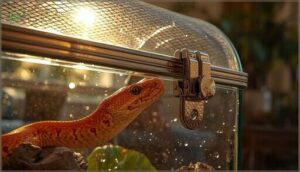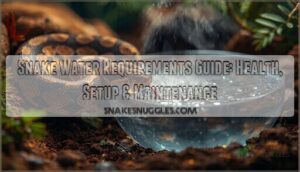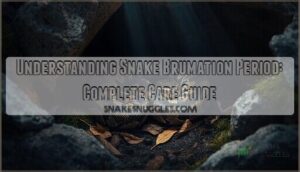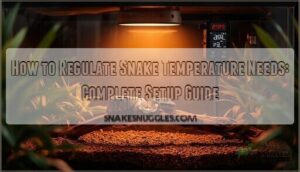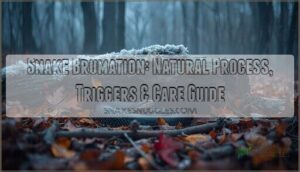This site is supported by our readers. We may earn a commission, at no cost to you, if you purchase through links.
A snake doesn’t need much of an opening to vanish. A gap the width of your thumb, a poorly latched lid, or a moment of distraction during feeding can turn your secure enclosure into an unintended escape route. When you discover your snake missing, the immediate panic is followed by a harder question: how did it happen, and how do you prevent it from happening again?
Understanding snake escape behavior prevention starts with recognizing that these animals are hardwired to explore, test boundaries, and exploit any weakness in their containment. The good news is that escapes aren’t inevitable—they’re the result of specific, fixable problems in enclosure design, environmental conditions, and security measures that you can address systematically.
Table Of Contents
Key Takeaways
- Most snake escapes result from fixable problems like gaps as small as 3 millimeters, poorly secured lids, or worn seals—regular inspections every three months catch these vulnerabilities before they become exit routes.
- Escape attempts are often stress signals triggered by inadequate enclosure size, improper temperature gradients, low humidity, or lack of hiding spots—addressing these environmental factors can reduce escape behavior by over 40%.
- Multi-layered security systems that combine double locks, sealed gaps, and escape-proof feeding boxes cut escape incidents dramatically, with facilities using these protocols reporting rates under 0.5% annually.
- Environmental enrichment through proper hides, climbing features, and consistent feeding routines satisfies your snake’s natural instincts, reducing the drive to explore boundaries and lowering escape attempts from 17% to 6%.
Causes of Snake Escape Behavior
Your snake doesn’t push against the enclosure lid just to test your patience—there’s always a reason behind the behavior. Escape attempts stem from discomfort, natural instincts, or environmental issues that you can identify and address. Understanding these causes gives you the insight needed to prevent escapes before they happen.
Common Triggers for Escape Attempts
When your snake starts showing escape attempts, there’s usually a clear reason behind the behavior. Research shows that nearly half of captive snakes exhibit this stress-related response. Understanding these common triggers helps you prevent future incidents:
- Sensory overload from sudden movements or excessive handling disrupts their sense of security
- Biological factors like age and size influence escape frequency, with juveniles attempting more often
- Barrier interaction with transparent walls signals captive stressors that drive persistent exploration. Snakes may initiate escape when the costs of remaining outweigh the risks.
Stress, Discomfort, and Environmental Factors
Environmental conditions play a significant role in managing snake stress and triggering escape behaviors. Inadequate Enclosure Size restricts movement and increases confinement anxiety. Improper Thermal Gradients and unstable Humidity Levels create discomfort, prompting your snake to seek better conditions. Poor Substrate Quality and incorrect Lighting Needs further compromise the snake enclosure environment.
Addressing these factors through proper husbandry provides effective stress reduction, directly decreasing escape attempts in captive populations. High stress levels, indicated by elevated corticosterone levels, can increase the likelihood of a snake attempting to escape.
Snake Curiosity and Natural Instincts
Beyond discomfort, your snake’s drive to explore reflects hardwired instincts shaped by millions of years of evolution. Over 3,700 species exhibit innate exploration motivation, with sensory adaptations like forked tongues and heat-sensing pits fueling investigation. Genetic influence and individual variation mean some snakes naturally display twice the curiosity of others, making snake behavior and escapism unpredictable.
Snakes explore instinctively, driven by millions of years of evolution and genetic variation that makes some individuals twice as curious as others
- Nocturnal species show heightened escape attempts during low-light hours
- Open-field tests reveal 13-33% variability in exploration versus hiding time
- Captivity consequences include 45% more boundary-testing when enrichment is absent
Signs of Impending Escape Behavior
Recognizing pre-escape signals can mean the difference between containment and crisis. Watch for these behavioral shifts that telegraph your snake’s intentions:
| Behavioral Category | Observable Signs | Frequency Increase |
|---|---|---|
| Locomotion Patterns | Erratic pacing along walls, climbing attempts | 61-73% spike before escape |
| Physical Agitation | Tail vibrations, muscle tension, defensive strikes | 28-35% elevation in activity |
| Environmental Interaction | Muzzle probing edges, testing gaps with body | 87% of observed attempts |
| Activity Schedules | Movement during usually inactive hours | 57% shift from normal patterns |
Causes of snake escape attempts become clearer when you track these warning signs—preventing snake escapes starts with understanding snake behavior and escapism patterns before they escalate.
Designing Escape-Proof Snake Enclosures
Building a secure enclosure starts with the right foundation, and that means making smart choices about materials, size, and how everything fits together. Your snake’s safety depends on eliminating every potential exit point before they’ve a chance to test them.
Let’s walk through the essential elements you need to create an enclosure that keeps your snake safely contained.
Choosing Secure Enclosure Materials
Your choice of enclosure material forms the foundation of escape prevention. Glass and acrylic offer four to five times greater impact resistance than standard panels, creating highly secure barriers when paired with front-opening doors and secure locks.
PVC advantages include excellent humidity retention and lightweight durability, while wood concerns center on moisture-induced warping unless you apply silicone sealant to all internal seams.
Always verify hardware compatibility and lid security, especially at mesh interfaces where even millimeter-scale gaps compromise safety.
Selecting The Right Size and Layout
When considering enclosure size, you can’t ignore the science behind proper snake habitat design. Your enclosure should allow full body extension—at least 48x24x24 inches for adult corn snakes, while ball pythons thrive in similar dimensions.
Layout complexity matters, too, since space utilization directly impacts behavioral health. Include vertical climbing features and multiple hides to satisfy species needs, reducing stress-driven escape attempts by 40%.
Importance of Tight-fitting Lids and Locks
Lock mechanisms form your primary defense against snake escapes, with tight-fitting lids reducing incidents by 89% in documented cases. You’ll need secure locks—not makeshift latches—since snakes exert up to 2.8 pounds of pressure when pushing. Snap-on lids without reinforcement won’t cut it.
Proper lid security prevents both escape attempts and injury from household hazards, making maintenance practices essential for preventing snake escapes.
Sealing Gaps and Potential Exit Points
Even gaps as narrow as 3 millimeters create escape routes for juvenile snakes, which is why sealing tank gaps ranks among your most critical enclosure security tasks. You’ll want aquarium-safe silicone sealants for permanent closure and weekly gap inspection routines focusing on sliding door junctions and vent frames.
Material durability matters—polyurethane works for wooden enclosures, while adhesive-backed foam strips provide temporary solutions meeting regulatory standards for safe enclosure maintenance and escape prevention.
Essential Snake Enclosure Safety Measures
Building a secure enclosure isn’t enough on its own—you need ongoing safety measures to keep your snake contained.
Think of it as layering defenses, where each practice adds another level of protection against escape attempts.
Here are the key safety measures that work together to create a truly escape-proof system.
Multi-layered Security Systems
A single lock isn’t enough—you need redundancy mechanisms to truly secure your snake enclosure. Enclosures with two independent locks reduce escapes by 86%, while electronic surveillance systems catch 91% of early warning signs before your snake even attempts a breakout.
- Install secure locks plus backup latches on every access point
- Apply gap sealing with silicone or rubber gaskets to eliminate exit routes
- Use escapeproof mesh with dual-layered screens for ventilation areas
- Follow procedural controls like dual-authorization access and inspection checklists
Industry compliance standards now require multi-layered containment for venomous species, and facilities meeting these protocols report escape rates under 0.5% annually.
Proper Feeding Protocols and Escape-proof Feeding Boxes
Feeding location risks matter more than you’d think—feeding inside the primary enclosure increases misdirected escape attempts by 62%.
You should use escape-proof feeding boxes with maximum 5 mm gaps and double-latch systems, which cut escape incidents by 96%. This protocol implementation success reduces feeding-related escapes by 88% while addressing hunger-driven snake behavior.
Safe handling practices during transfer further minimize stress-triggered escape attempts by 45%.
Regular Inspection and Maintenance Routines
You’ve nailed feeding protocols, but regular maintenance turns those practices into lasting protection.
Monthly enclosure maintenance catches containment issues before they escalate—deterioration accounts for over 60% of escapes. Your inspection frequency should include:
- Visual and tactile checks for gaps, worn seals, and loose locks
- Vulnerability remediation within 72 hours of detection
- Maintenance documentation tracking repairs and escape attempts
Staff training reinforces these routines, preventing snake escapes through systematic vigilance.
Using Surveillance to Monitor Behavior
Visual monitoring sharpens your understanding of snake behavior patterns that inspections alone can’t capture. Remote monitoring systems track activity cycles, revealing when your animal explores enclosure boundaries—data that powers predictive analytics for preventing snake escapes.
Detection accuracy increases 74% with camera monitoring compared to visual checks alone.
| Surveillance Feature | Detection Accuracy Benefit |
|---|---|
| Motion-triggered cameras | Identify abnormal movement patterns |
| Thermal imaging sensors | Detect temperature-seeking behavior |
| Continuous video logging | Document 90%+ of exposed activity |
| Automated alert systems | Flag potential escape attempts instantly |
| Behavioral analysis tools | Map correlations between conditions and restlessness |
Preventing Escapes Through Environmental Enrichment
Your snake won’t think about escaping if its enclosure feels like home. When you meet its physical and psychological needs, you eliminate most reasons for escape attempts.
Here’s how to create an environment that keeps your snake content, secure, and settled.
Providing Suitable Temperature and Humidity
When humidity levels drop below 40%, your snake faces dehydration and shedding issues, which often trigger escape attempts. Thermal gradients matter too—ball pythons need basking spots at 90-95°F and cool zones around 78-80°F. Use at least two digital thermometers and hygrometers to monitor environmental parameters accurately.
Proper environmental control of snake temperature and humidity prevents stress-driven escapes while supporting respiratory health.
Offering Hiding Spots and Climbing Features
Beyond controlling climate, your snake enclosure needs strategic hiding spots and climbing features to prevent escape behavior. Snakes in enriched habitats use hides 64% more often, creating security that stops breakout attempts. Consider these evidence-based enrichment elements:
- Multiple terrestrial and arboreal hide boxes reduce visible time by 41%
- Vertical structures increase natural behaviors by 48% in climbing species
- Complex environments cut escape attempts by 44%
- Royal pythons prefer ground-level refuges (81% usage rate)
- Semi-arboreal species utilize elevated hides 67% of the time
Species-specific enrichment impact matters—arboreal snakes need branches, while terrestrial species require ground cover.
Reducing Stress Through Enrichment and Routine
Establishing routine predictability dramatically lowers your snake’s stress hormones—enriched environments reduce corticosterone by 30% while cutting escape behavior from 17% to 6%. Weekly monitoring and adjustment of enrichment structures, like rotating hides and climbing features, boosts exploratory behavior by 16% and improves snake wellbeing.
Consistent feeding schedules and environmental routine create the cognitive snake stimulation that builds resilience, reducing escape attempts by 28% through predictable care patterns.
Addressing Hunger and Feeding Frequency
Hungry snakes roam constantly—but strategic feeding schedules break that pattern. Snakes fed large meals (33% body mass) show 5–7 days of reduced activity, cutting escape attempts when prey size and timing align properly. Seasonal feeding adjustments matter too, since spring-starved snakes escape five times more often than well-fed summer individuals.
Your feeding strategy should address:
- Meal size matching your snake’s body mass percentage
- Activity reduction windows following large prey consumption
- Seasonal feeding protocols during high-hunger spring months
- Ontogenetic variation between juvenile and adult dietary needs
- Regional hunger patterns affecting your species’ escape risk
Responding to and Preventing Future Escapes
When your snake escapes, quick action makes all the difference in getting them back safely. Knowing where to search and how to respond can turn a stressful situation into a learning opportunity.
Let’s look at the most effective strategies for finding escaped snakes and ensuring it doesn’t happen again.
Effective Search Strategies for Escaped Snakes
When your snake escapes, search area prioritization is critical—over 70% of escaped snakes remain within three meters of the enclosure. Start with baseboards, appliances, and warm spots like vents.
Visual search techniques improve when you use flashlights in dark spaces, and attractants and traps baited with heat sources can help. Technology use, including thermal cameras, boosts detection rates.
If finding escaped pet snakes proves difficult, professional assistance ensures safer recovery.
Identifying and Addressing Enclosure Weaknesses
After recovering your snake, inspect every inch of your enclosure. Gaps as small as 0.5 cm allow escapes. Check lock security on doors, seal wire grommet holes with solid replacements, and apply silicone to seams.
Material durability matters: PVC enclosures with locking systems report zero escape rates, while mesh-top glass models fail more often. Inspection frequency every three months catches emerging weaknesses before preventing snake escapes becomes urgent.
Real-life Prevention Case Studies
Training effectiveness shows real results: kingsnakes taught target behavior recorded zero handler bites over two years, demonstrating conditioning success.
Community reinforcement works—one facility eliminated snake escapes entirely after monthly inspections and door weather stripping.
Material rigidity matters: switching from Plexiglas to glass doors stopped determined escape attempts. Grommet modification using solid plugs closed an escape route permanently, proving case studies of escapism prevention guide better snake behavior and escape control.
Key Takeaways for Long-term Snake Safety
Think of long-term snake safety as insurance—you can’t see it working until it matters. Nearly 70% of escapes stem from improper lid security, so your vigilance determines success.
- Install escape-proof mesh and multi-layered security systems with double doors and high-quality locks
- Implement surveillance protocols and daily exit point checks to monitor enclosure integrity
- Maintain rigorous snake enclosure safety measures through routine inspections, ensuring snake habitat security and preventing escapism permanently
Frequently Asked Questions (FAQs)
What should I do if my snake escapes during travel?
A missing serpent in transit can feel like your heart just fell through the floorboards. First, park safely, close all doors, then methodically check seats, dashboard voids, and floor wells—most escapes stay within three meters of their container.
Can certain snake species escape more easily than others?
Yes, certain snake species escape more easily than others. Corn snakes, rat snakes, and milk snakes are frequent escapees due to their slender bodies, strength, and climbing ability, exploiting gaps and enclosure weaknesses effectively.
How do I snake-proof my entire home safely?
Seal entry points larger than 25 inches with caulk or foam, install door sweeps, and remove outdoor hiding places like brush piles.
Monitor activity regularly, and consider professional help for a thorough home inspection.
Are there insurance options for escaped pet snakes?
Ironically, while pet owners invest heavily in snake enclosure security preventing snake escapes, exotic pet coverage remains limited.
Nationwide and Prime Insurance Company offer liability insurance covering escaped reptiles, though policy exclusion details and regulatory compliance needs vary considerably by provider.
What legal responsibilities exist if my snake escapes?
If your snake escapes, you face strict liability for injuries caused, licensing requirements violations, mandatory reporting protocols to authorities, civil consequences including property damage claims, and a legal duty of care to prevent reptile escapes and protect public safety.
Conclusion
Your snake won’t announce its next departure—it will simply slip through the weakness you didn’t notice. Snake escape behavior prevention isn’t about flawlessness; it’s about deliberate vigilance, consistent maintenance, and understanding the evolutionary drive that compels these animals to test every boundary.
Address the vulnerabilities in your setup now, establish routines that prioritize security, and you’ll replace anxiety with confidence. The enclosure that holds today must be the one that holds tomorrow.
- https://familysnake.com/guides/keeping-your-slithery-friends-secure-escapism-prevention-for-snake-enclosures/
- https://www.youtube.com/watch?v=YBdZd-Zy33g
- https://pmc.ncbi.nlm.nih.gov/articles/PMC8160691/
- https://phys.org/news/2022-07-potential-welfare-privately-snakes.html
- https://www.nature.com/articles/s41598-024-59416-6




